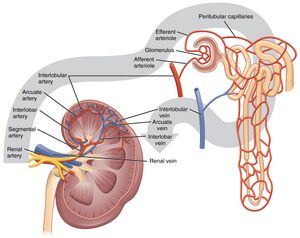Renal Blood Flow
The kidneys are the main component of the excretory system. The arrangement of the vessels is crucial for its proper function.
Vascular Arrangement in the Kidneys[edit | edit source]
Per minute, approximately 1.2 - 1.3 litres of blood will flow into the kidneys (aka 25% of the resting cardiac output of the renal artery (a. renalis), which branching to become the segmental arteries (aa. segmentalis). These further branch go interlobar arteries (aa. interlobares), and further into the arcuate arteries (aa. arcuatae). 90% of blood flows to the cortex, leaving the rest to flow in the renal medulla. Vas afferent opens into a capillary bed in the renal glomerulus, where an ultrafiltrate of blood plasma is formed. Filtration is due to the action of the Starling Forces on the vessel wall (see glomerular filtration). The renal circulation si characterized by a system of two capillary networks - glomerular and peritubular. The glomerular is high pressure (60mm Hg), which is due to the relative proximity of the aorta. The peritubular network is low pressure (8mm Hg) and follows the glomerular network. Along the Loop of Henle, there is the vasa recta that functions to drain the resorbed substances back into the circulation. The veins in the rest of the circulation are called the same as the arteries.
Regulatory Mechanisms of the Renal Circulation[edit | edit source]
Like other organs, blood flow in the kidneys has its own regulatory mechanisms, which can be divided into local and central. They are used especially in changes in blood pressure, in order to maintain a constant glomerular filtration. In general, vasoconstriction reduces glomerular filtration, vasodilation increases it.
Local regulation[edit | edit source]
Under physiological circumstances, local regulation plays a major role in maintaining a constant renal flow. In particular, the following mechanisms apply.
- Myogenic autoregulation - maintains a constant blood flow, With increased blood pressure, the tension on the capillary wall increases. As a result of stimulation of baroreceptors, vasoconstriction of the afferent arteriole occurs. The blood flow through the vessel is thus normalized. In the oppostie situation, reduced blood pressure causes vasodilation with a consequent increase in flow;
- Tubuloglomerular feedback - macula densa cells produce signalling molecules to which the smooth muscle in your afferent arteriole responds, and as a result can detect the amount of flow in the tubular fluid. The feedback mechanism consists of the detection of reduced blood flow through the macula densa (decrease glomerular filtration) and the release of paracrine signaling molecules that have a vasodilatory effect on the vas afferens receptors. A vice versa effect occurs upon the increase of glomerular filtration.
Local regulatory mechanisms can maintain constant glomerular filtration even with changes in blood pressure from 80 to 180 mm Hg.
This type of regulation is used especially in pathological conditions (eg. loss of a larger volume of fluids). With changes in arterial pressure, local regulatory mechanisms fail and central regulatory mechanisms with nervous and hormonal action apply.
- The sympathetic nervous system mainly acts as you afferens and, by means of its α1 - adrenergic receptors, induces constriction after the binding of adrenaline or noradrenaline;
- Angiotensin II has receptors located in both your vas afferens and your vas efferens. It is involved in the stimulation of catecholamines from the adrenal medulla and from sympathetic endings. It causes contraction of mesangial cells and reduces glomerular filtration.
- Prostaglandins are not used in physiological situations. In pathological conditions, they are produced locally in the kidneys. Their vasodilatory effect on vas afferens and vas efferens seeks to prevent ischemia, which is threatened by the action of catecholamines and angiotensin II, whose increased activity is a stimulus for prostaglandin flushing.
Other substances that potentiate blood flow in the glomerulii include: atrial natriuretic peptide, glucocorticoids, nitric oxide, kinins. Other vasoconstrictors are eg. antidiuretic hormone, ATP, endothelin.
Links[edit | edit source]
External Links[edit | edit source]
Reference[edit | edit source]
- GANONG, William F. Přehled lékařské fyziologie. 20. vydání. Praha : Galén, 2005. 890 s. s. 709. ISBN 80-7262-311-7.
- Skočit nahoru↑ KITTNAR, Otomar, et al. Lékařská fyziologie. 1. vydání. Praha : Grada, 2011. 790 s. s. 390. ISBN 978-80-247-3068-4.
- Skočit nahoru↑ SILBERNAGL, Stefan a Agamemnon DESPOPOULOS. Atlas fyziologie člověka. 6. vydání. Praha : Grada, 2003. 435 s. s. 150. ISBN 80-247-0630-X.
Resources[edit | edit source]
- KITTNAR, Otomar. Lékařská fyziologie. 1. vyd. Praha: Grada, 2011. ISBN 978-80-247-3068-4.
- TROJAN, Stanislav. Lékařská fyziologie. 4. vyd. přepr. a dopl. Praha: Grada Publishing, 2003, 771 s. ISBN 80-247-0512-5.
- Kidneys, Water and Ion Balance and Acid-Base Balance (fblt.cz)
Kategorie:Anatomie Kategorie:Fyziologie

